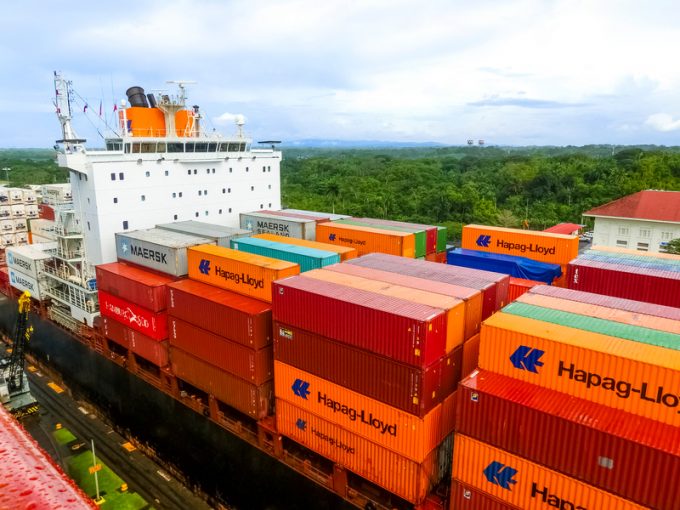Bolloré bounce boosts CMA CGM Q2 revenues, but job worries persist
CMA CGM Group has announced a “robust performance” in the second quarter, with revenues up ...
TFII: SOLID AS USUALMAERSK: WEAKENINGF: FALLING OFF A CLIFFAAPL: 'BOTTLENECK IN MAINLAND CHINA'AAPL: CHINA TRENDSDHL: GROWTH CAPEXR: ANOTHER SOLID DELIVERYMFT: HERE COMES THE FALLDSV: LOOK AT SCHENKER PERFORMANCEUPS: A WAVE OF DOWNGRADES DSV: BARGAIN BINKNX: EARNINGS OUTODFL: RISING AND FALLING AND THEN RISING
TFII: SOLID AS USUALMAERSK: WEAKENINGF: FALLING OFF A CLIFFAAPL: 'BOTTLENECK IN MAINLAND CHINA'AAPL: CHINA TRENDSDHL: GROWTH CAPEXR: ANOTHER SOLID DELIVERYMFT: HERE COMES THE FALLDSV: LOOK AT SCHENKER PERFORMANCEUPS: A WAVE OF DOWNGRADES DSV: BARGAIN BINKNX: EARNINGS OUTODFL: RISING AND FALLING AND THEN RISING

Hapag-Lloyd recorded a net Q3 profit of $290m, up 73%, to take the carrier’s profit for the nine-month period to $605m, nearly double the $333m achieved the previous year.
However, the carrier’s most profitable quarter could be yet to come, given that Hapag-Lloyd’s accounting system works on an end voyage basis, lagging most of its peers by two to three weeks.
As a result, some increases in spot rates in Q3 will work through into the final accounting period.
Transported volumes in Q3 declined 3.4% on last year, to 2.9m teu, while revenue dipped 2.5% to $3.52bn. This produced an ebitda of $756m, compared with $617m in Q3 19, and a net profit of $290m, versus $168m.
Hapag-Lloyd’s average rate per teu during Q3 was, surprisingly, unchanged at $1,084, so the improved profitability was mostly attributable to cost savings, including cheaper fuel.
“It’s pretty clear there has been a better-than-expected rebound in demand, and earnings have been good on the back of low bunker costs,” said CEO Rolf Habben Jansen today.
“At least until the Chinese New Year, the market looks to be very strong,” he said , but added that “it was not logical” that the demand strength would continue indefinitely.
“With an increasing number of cases worldwide, the Covid-19 pandemic continues to pose high risks to the logistics industry and the supply chains of our customers,” he cautioned.
However, he said, all the carrier’s business sectors were continuing to perform well – the exception had been the transatlantic trade, which had been “a little sluggish but is showing signs of picking up, and ships are running full”.
Mr Habben Jansen was reluctant to comment on contract rate negotiations on the Asia-Europe tradelane, which traditionally commence at this time of year, but accepted that it would be “very odd” to see contract rates for next year going down.
Giving an insight into Hapag-Lloyd’s business model across its tradelanes, he said around a third of liftings consisted of annual contracts, another third from shorter-term contracts of three-to-six months and the final third from the spot market.
He added that “quite a lot” of contract cargo in the quarter had been transported on Hapag-Lloyd vessels at some 50% below the spot market level.
The Loadstar has heard from several Asia-North Europe shippers that some carriers were “refusing to sit down” to negotiate new annual contracts, preferring to concentrate on the more lucrative short-term market.
Mr Habben Jansen said Hapag-Lloyd’s digital Quick Quotes product had garnered around 1.2m teu of business so far this year, adding that forwarders represented 80%-90% of its users.
On equipment shortages, he said “quite a lot of empty boxes remain stuck in the UK”, and that repositioning to Asia was “a fairly big challenge”. He maintained that equipment surcharges were designed to “steer” shippers to use other boxes instead of the popular 40ft high-cubes.
Hapag-Lloyd is maintaining its full-year earnings guidance of €1.1bn-€1.3bn which it upgraded in October and Mr Habben Jansen rejected a suggestion that the carrier was being “too conservative”.
Comment on this article